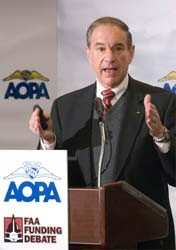Boyer Briefs Reporters Ahead Of Bush's Budget Submission
 Phil
Boyer, President of The Aircraft Owners and Pilots
Association, has never been one to mince words, and his press
conference with Washington DC reporters regarding the ongoing
debate over FAA and airline-proposed user fees was no exception.
Boyer met with reporters at the National Press Club ahead of
President Bush's fiscal year 2008 budget submission to Congress
scheduled for next week.
Phil
Boyer, President of The Aircraft Owners and Pilots
Association, has never been one to mince words, and his press
conference with Washington DC reporters regarding the ongoing
debate over FAA and airline-proposed user fees was no exception.
Boyer met with reporters at the National Press Club ahead of
President Bush's fiscal year 2008 budget submission to Congress
scheduled for next week.
Briefing reporters on what AOPA sees as the key items in the
upcoming budget submission, Boyer (right) said the FAA is seeking a
radical new user-fee based funding system, and dramatic tax
increases for aviation users.
Boyer said, "The administration is manufacturing an FAA 'funding
crisis' in a smoke-and-mirrors attempt to divert attention away
from the real issue -- the need to address the problems that
constrain capacity, efficiency, and new technology adoption.
"They are attempting an end-run around Congress to put the
world's safest, most efficient, and largest air traffic control
system into the hands of airline barons who've flown their own
businesses into bankruptcy."
Boyer warned the proposed funding changes could significantly
decrease congressional authority for FAA spending and oversight,
and reduce or eliminate taxpayer support for and control of the
FAA's critical public safety functions.
AOPA sees congressional oversight of the FAA as critical. Former
DOT inspector general Ken Mead joined Boyer at the podium to add,
"You need the checks and balances of the US Congress."
He recalled that Congress had shut down the microwave landing
system and the previous attempt at modernization -- the advanced
automation system (AAS) -- when it had spun out of control and
gone well over budget.
 "I had to testify more times than I
can recall on AAS," said Mead, "and it is a fact that it was
stopped in its tracks by the checks and balances of Congress."
"I had to testify more times than I
can recall on AAS," said Mead, "and it is a fact that it was
stopped in its tracks by the checks and balances of Congress."
Mead's analysis of future FAA revenue based on projections in
the administration's budget for 2006 shows the agency could double
its current spending on modernization -- up to $20 billion over the
next five years -- while still enjoying a surplus, assuming a
continuing contribution from the general fund.
The FAA has said a loss of revenues due to lower fares has led
to a reduction in the aviation trust fund.
But Boyer says administration claims of slumping revenue and a
dwindling trust fund are just bogus justifications for a user fee
system.
According to AOPA, the major portion of the FAA's budget
traditionally has been paid for from the aviation trust fund, which
gets its revenue from federal excise taxes on aviation fuel (much
like highway gas taxes), and taxes on airline tickets and air cargo
bills. About 25 percent of the agency's budget has been funded from
the general fund because of benefits to the general public from a
safe, regulated air transportation system.
"This system has worked well for nearly four decades and will
continue to meet what the FAA says it will need for future
modernization," said Boyer. Boyer said that if the current funding
system were continued, the surplus in the aviation trust fund will
exceed $7 billion by 2012, while providing some $20 billion over
the next five years for FAA capital expenses including air traffic
control modernization, plus the historical contribution to airport
infrastructure of $3.7 billion per year.
But the FAA doesn't yet know what modernization will look like
or what it will cost.
"We strongly support modernizing the air transportation system
to reduce costs and improve efficiency, but the FAA doesn't have a
final system design. They just think that whatever it is they pick,
it will cost as much as $20 billion," said Boyer. "No matter what
they do to improve capacity and efficiency in the sky, it won't fix
a system in which the airlines schedule 50 aircraft onto a runway
that can only handle 30."
 And it is airline control of a
future air traffic control and funding system that particularly
upsets the nation's private pilots and aircraft owners says Boyer.
Various user fee proposals circulated through government grapevines
envision an airline-dominated board removing spending decisions
from Congress. The airlines would have a strong hand in determining
what they charge themselves and other minority system users.
And it is airline control of a
future air traffic control and funding system that particularly
upsets the nation's private pilots and aircraft owners says Boyer.
Various user fee proposals circulated through government grapevines
envision an airline-dominated board removing spending decisions
from Congress. The airlines would have a strong hand in determining
what they charge themselves and other minority system users.
"There is nothing inherent in the user fee proposals that
addresses the issues of future airspace capacity, new technology,
increased efficiency, and more runway capacity," said Boyer, "so
you have to wonder; what's in it for the airlines?
"Wherever in the world user fee systems have been implemented,
they've proven to be expensive, complicated, financially unstable,
and harmful to the average citizen flying an aircraft for business
or personal transportation."
Boyer said that taxes are the most efficient and cost-effective
way to fund the FAA. Citing Treasury Department data, he noted that
collection costs amounted to a mere 0.001 percent of the total
raised for the aviation trust fund.
"A complicated user fee system, with the legions of clerks,
accountants, and managers needed to send out, process, and collect
bills, could not be nearly as cost effective," said Boyer.
"Our aviation transportation system should be treated like all
other public benefit government functions when it comes to
financing," said Boyer. "Whether it be airways, highways, or public
education, funding should come from generally applied taxes,
calibrated to the ability to pay."
AOPA has launched a dedicated website to monitor the user fee
issue, and report on general aviation's progress against the forces
pushing for such fees against GA pilots. That website is available
here.
The more-than-410,000-member Aircraft Owners and Pilots
Association has represented the interests of general aviation
pilots since 1939. General aviation includes all flying except the
scheduled airlines and the military. Two-thirds of all US pilots,
and three-quarters of the GA pilots, are AOPA members.
 Bolen Gives Congress a Rare Thumbs-Up
Bolen Gives Congress a Rare Thumbs-Up The SportPlane Resource Guide RETURNS!!!!
The SportPlane Resource Guide RETURNS!!!! Buying Sprees Continue: Textron eAviation Takes On Amazilia Aerospace
Buying Sprees Continue: Textron eAviation Takes On Amazilia Aerospace Hawker 4000 Bizjets Gain Nav System, Data Link STC
Hawker 4000 Bizjets Gain Nav System, Data Link STC Echodyne Gets BVLOS Waiver for AiRanger Aircraft
Echodyne Gets BVLOS Waiver for AiRanger Aircraft





